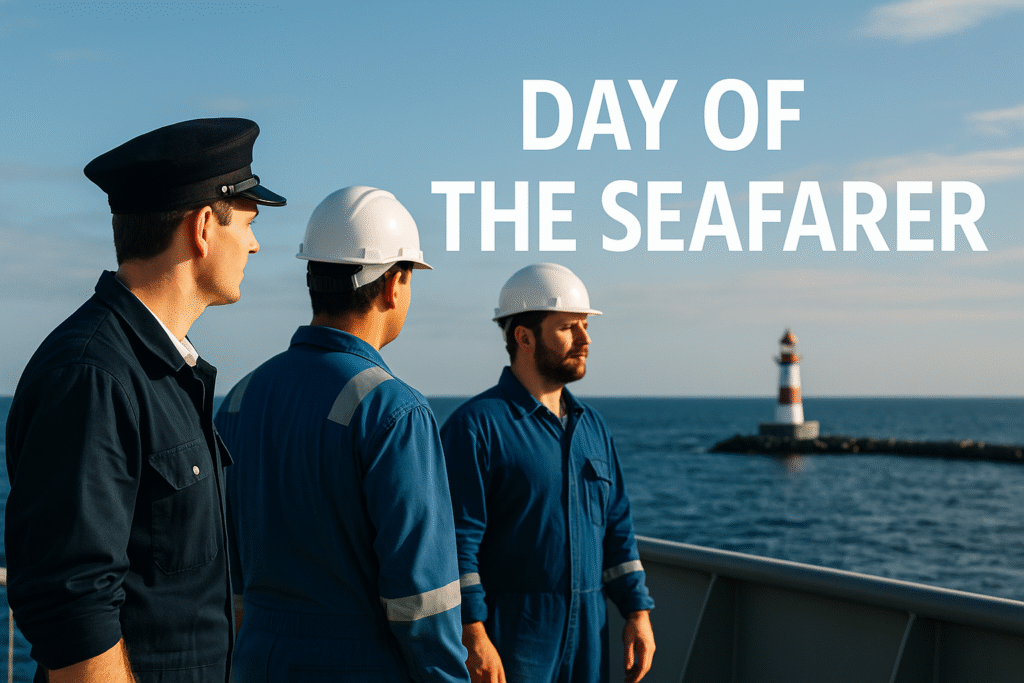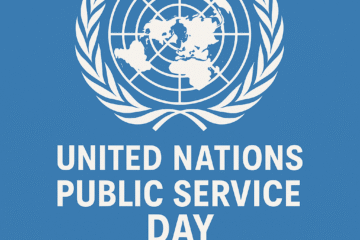
Table of Contents
The rhythmic pulse of global trade, the seamless flow of goods across continents, and the vital connectivity that underpins modern economies are often taken for granted by those on land. Yet, behind this intricate dance of commerce lies a dedicated workforce, the unsung heroes who brave the oceans: the seafarers. Every year, on June 25th, the world comes together to acknowledge their indispensable role through the Day of the Seafarer. This observance, established by the International Maritime Organization (IMO), serves as a crucial reminder of the sacrifices made, the challenges faced, and the invaluable contributions delivered by these silent pillars of global prosperity.
The Genesis of Recognition: Why the Day of the Seafarer Matters
For centuries, seafarers have navigated the treacherous waters, connecting distant lands and facilitating the exchange of cultures and commodities. However, their efforts often remained unseen, their lives a mystery to those benefiting from their labor. Recognizing this profound oversight, the IMO, a specialized agency of the United Nations responsible for regulating shipping, took a significant step. In 2010, the IMO’s Diplomatic Conference adopted a resolution establishing the Day of the Seafarer as an official United Nations observance. This decision, enshrined in Resolution 19 of the revised STCW Convention (Standards of Training, Certification and Watchkeeping for Seafarers), was a direct call to action, urging governments, shipping organizations, and the public to pay tribute to the millions of men and women who work on board ships.
The rationale behind its establishment was clear: to raise awareness about the critical role seafarers play in the world economy and civil society. It aimed to encourage a broader understanding of their profession, which, despite its immense importance, is fraught with unique hardships and often goes unrecognized. The Day offers a unique opportunity to celebrate their contributions, advocate for their rights, and address the pressing issues that affect their welfare and well-being.
The Indispensable Role of Seafarers: Keeping the World Afloat
Imagine a world without maritime transport. Shelves would be empty, factories would grind to a halt, and economies would collapse. Over 80% of global trade by volume, including everything from oil and gas to cars, food, medicines, and consumer goods, is carried by sea. It is the most efficient and cost-effective method for transporting large quantities of goods over vast distances. At the heart of this colossal operation are the approximately two million seafarers worldwide.
These men and women operate a vast fleet of merchant ships – bulk carriers, oil tankers, container ships, cruise liners, chemical carriers, and more. Their responsibilities are immense: navigating complex shipping lanes, managing sophisticated machinery, ensuring cargo safety, adhering to stringent international regulations, and maintaining the structural integrity of their vessels. They are engineers, navigators, cooks, mechanics, doctors, and diplomats, all rolled into one, living and working in a confined environment for months on end, far from family and familiar comforts. The global supply chain, which consumers on land rely upon daily, would simply cease to function without their unwavering dedication.
The COVID-19 pandemic starkly illuminated their essential status. When borders closed and supply chains buckled, seafarers continued to work, often stranded at sea for extended periods, unable to be repatriated or access medical care. They ensured that vital supplies, including medical equipment, food, and energy, reached their destinations, highlighting their role as true frontline workers in a global crisis. The Day of the Seafarer during these years served as a poignant reminder of their resilience and sacrifice.
Navigating the Storm: The Challenges Faced by Seafarers
While the sea offers a unique existence, it is also a demanding and often unforgiving workplace. Seafarers confront a unique array of challenges that are largely invisible to the public.
Isolation and Mental Health: Perhaps the most pervasive challenge is profound isolation. Months away from home, with limited communication options, and in close quarters with a small crew can take a significant toll on mental well-being. Loneliness, stress, and anxiety are common, and access to mental health support can be scarce. The lack of social interaction outside the ship and the absence of personal space contribute to a demanding psychological environment.
Piracy and Security Threats: Despite international efforts, piracy remains a serious threat in certain high-risk areas, such as the Gulf of Aden, the West African coast, and Southeast Asia. Seafarers constantly live with the fear of attack, capture, and ransom, which can lead to severe psychological trauma, even if they are fortunate enough to escape physical harm.
Fatigue and Long Working Hours: The demands of a 24/7 operation, strict watchkeeping schedules, and port turnaround pressures often lead to prolonged working hours and chronic fatigue. This not only impacts their health but also significantly increases the risk of accidents and human error, jeopardizing their lives and the safety of the vessel and its cargo.
Repatriation Issues: Despite international conventions, seafarers frequently face difficulties with repatriation at the end of their contracts. Port restrictions, visa complications, and inadequate support from employers can leave them stranded on board for months beyond their agreed-upon term, leading to immense distress and even abandonment.
Regulatory Burden and Criminalization: Seafarers often operate under a complex web of international and national regulations. In the event of an incident, they can face harsh legal consequences, including criminalization, even when they are not solely responsible. This creates an environment of fear and adds to the stress of their profession.
Technological Advancements: While technology improves safety and efficiency, it also necessitates continuous upskilling. Seafarers must adapt to increasingly automated systems, digital navigation, and data analysis, requiring ongoing training and a flexible mindset. This can add pressure, especially for older seafarers.
Shore Leave Restrictions: Due to strict port security regulations, crew changes, and rapid turnaround times, many seafarers have little or no opportunity to go ashore when their ship is in port. This further exacerbates feelings of isolation and disconnect from the world on land.
These challenges underscore the urgent need for continued advocacy and support, making the annual Day of the Seafarer an essential platform for addressing these issues.
Themes and Celebrations: A Global Call to Action
Each year, the IMO designates a specific theme for the Day of the Seafarer, focusing attention on a particular aspect of seafarers’ lives or contributions. Past themes have included “Seafarers Matter,” “Seafarers’ Well-being,” “Connecting Ships, Ports and People,” and “Fair Future for Seafarers.” These themes guide campaigns and discussions, encouraging stakeholders to reflect on specific areas needing improvement or recognition.
The celebration of the Day typically involves a range of activities globally:
IMO Campaigns: The IMO launches social media campaigns, inviting the public to share messages of gratitude and support for seafarers using specific hashtags. They also release videos and infographics to educate the public.
Shipping Industry Events: Maritime organizations, shipping companies, ports, and unions often host events, webinars, and conferences to highlight the importance of seafarers, discuss welfare issues, and promote careers at sea.
Government Initiatives: Some governments use the Day to announce new policies or funding for seafarer welfare programs, including mental health support, training, and improved repatriation procedures.
Public Awareness Campaigns: Non-profits and maritime charities engage in public outreach, organizing events, publishing articles, and producing documentaries to shed light on the lives of seafarers.
Individual Acts of Recognition: People are encouraged to take a moment to appreciate the origin of the goods they consume and acknowledge the invisible workforce that brought them.
The Day of the Seafarer is not just a ceremonial event; it is a catalyst for change. It prompts a global dialogue about how to better support those who keep the world moving.
Bridging the Gap: Public Awareness and the Future of Seafaring
One of the primary goals of the Day of the Seafarer is to bridge the chasm of understanding between those on land and those at sea. For many, the maritime industry is an abstract concept, disconnected from their daily lives. By shining a spotlight on seafarers, the observance aims to foster empathy and appreciation. When consumers understand that every imported product, every barrel of oil, and every piece of cargo has been handled and transported by a seafarer, the appreciation for their work grows.
Looking ahead, the future of seafaring will be shaped by ongoing advancements in technology, the imperative for decarbonization, and the continued focus on human rights and welfare. The Day of the Seafarer will remain instrumental in ensuring that seafarers are not left behind in these transformations. Efforts will continue to focus on:
Enhanced Welfare and Mental Health Support: Providing better access to communication, shore leave, counseling services, and recreational facilities.
Improved Connectivity: Ensuring reliable and affordable internet access on board ships to reduce isolation and allow seafarers to connect with their families.
Fair Employment Practices: Upholding fair wages, decent working conditions, and robust contracts that protect seafarers from exploitation and abandonment.
Skills Development: Preparing seafarers for the digitalized and decarbonized ships of the future through comprehensive training and reskilling programs.
Protection from Piracy and Criminalization: Continuing international cooperation to combat maritime crime and ensure fair treatment under the law.
Conclusion: A Debt of Gratitude
The Day of the Seafarer stands as a powerful annual reminder of the immense debt of gratitude owed to the world’s seafarers. They are the unseen hands that steer the global economy, enduring isolation, danger, and hardship to deliver the goods and resources that sustain our modern lives. Their resilience, dedication, and professionalism are truly remarkable. As we celebrate this day, it is not merely a formality but a genuine call to action: to acknowledge their pivotal role, to advocate for their rights, to improve their working and living conditions, and to ensure that these essential workers receive the recognition, respect, and support they so profoundly deserve. Let us remember that every item we consume, every product we use, carries with it the silent story of a seafarer’s journey.
Frequently Asked Questions
1. What is the Day of the Seafarer?
Ans. The Day of the Seafarer is an annual international observance dedicated to recognizing the invaluable contribution that seafarers make to global trade and the world economy. It highlights their vital role in keeping supply chains moving and acknowledges the unique challenges they face.
2. When is the Day of the Seafarer observed?
Ans. The Day of the Seafarer is celebrated annually on June 25th.
3. Who established the Day of the Seafarer?
Ans. The Day of the Seafarer was established by the International Maritime Organization (IMO), a specialized agency of the United Nations responsible for regulating shipping. It was adopted in 2010 at the IMO’s Diplomatic Conference.
4. Why are seafarers so important to the global economy?
Ans. Seafarers are crucial because they operate the ships that transport over 80% of global trade by volume, including essential goods like oil, gas, food, medicines, and consumer products. Without them, international trade would come to a halt, significantly impacting economies worldwide.
5. What are some of the main challenges faced by seafarers?
Ans. Seafarers face numerous challenges, including profound isolation and mental health issues due to long periods away from home, the constant threat of piracy, long working hours leading to fatigue, difficulties with repatriation, complex regulatory burdens, and limited shore leave.
6. Approximately how many seafarers are there globally?
Ans. There are approximately two million men and women working as seafarers worldwide, operating the vast global merchant fleet.
7. What role did seafarers play during the COVID-19 pandemic?
Ans. During the COVID-19 pandemic, seafarers were recognized as essential frontline workers. Despite severe restrictions, travel bans, and extended periods at sea (often unable to be repatriated), they continued to transport vital supplies, including medical equipment, food, and energy, ensuring global supply chains remained operational.
8. What kind of themes does the IMO set for the Day of the Seafarer?
Ans. Each year, the IMO sets a specific theme for the Day of the Seafarer to focus attention on a particular aspect of seafarers’ lives or contributions. Past themes have included “Seafarers Matter,” “Seafarers’ Well-being,” “Connecting Ships, Ports and People,” and “Fair Future for Seafarers.”
9. How is the Day of the Seafarer celebrated or observed worldwide?
Ans. The Day is observed through various activities, including social media campaigns by the IMO, events and webinars hosted by maritime organizations, government initiatives to support seafarer welfare, and public awareness campaigns by non-profits to educate people about the importance of seafarers.
10. How can the general public show support for seafarers on this day?
Ans. The public can show support by taking a moment to appreciate the origin of the goods they consume and acknowledging the seafarers who transported them. They can also participate in IMO social media campaigns (e.g., using designated hashtags), learn more about the maritime industry, and support organizations dedicated to seafarer welfare.


